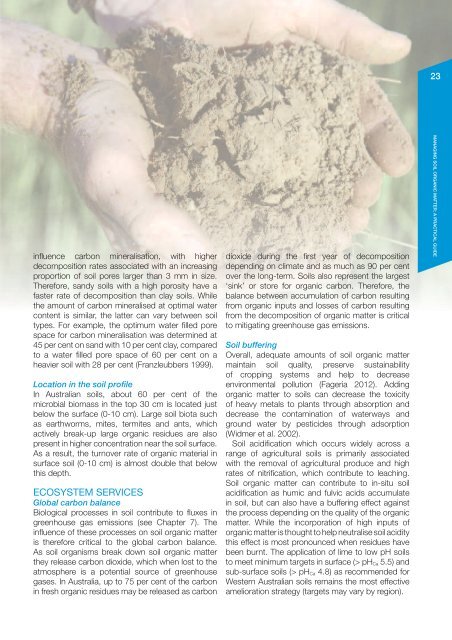managing soil organic matter - Grains Research & Development ...
managing soil organic matter - Grains Research & Development ...
managing soil organic matter - Grains Research & Development ...
Create successful ePaper yourself
Turn your PDF publications into a flip-book with our unique Google optimized e-Paper software.
23influence carbon mineralisation, with higherdecomposition rates associated with an increasingproportion of <strong>soil</strong> pores larger than 3 mm in size.Therefore, sandy <strong>soil</strong>s with a high porosity have afaster rate of decomposition than clay <strong>soil</strong>s. Whilethe amount of carbon mineralised at optimal watercontent is similar, the latter can vary between <strong>soil</strong>types. For example, the optimum water filled porespace for carbon mineralisation was determined at45 per cent on sand with 10 per cent clay, comparedto a water filled pore space of 60 per cent on aheavier <strong>soil</strong> with 28 per cent (Franzleubbers 1999).Location in the <strong>soil</strong> profileIn Australian <strong>soil</strong>s, about 60 per cent of themicrobial biomass in the top 30 cm is located justbelow the surface (0-10 cm). Large <strong>soil</strong> biota suchas earthworms, mites, termites and ants, whichactively break-up large <strong>organic</strong> residues are alsopresent in higher concentration near the <strong>soil</strong> surface.As a result, the turnover rate of <strong>organic</strong> material insurface <strong>soil</strong> (0-10 cm) is almost double that belowthis depth.ECOSYSTEM SERVICESGlobal carbon balanceBiological processes in <strong>soil</strong> contribute to fluxes ingreenhouse gas emissions (see Chapter 7). Theinfluence of these processes on <strong>soil</strong> <strong>organic</strong> <strong>matter</strong>is therefore critical to the global carbon balance.As <strong>soil</strong> organisms break down <strong>soil</strong> <strong>organic</strong> <strong>matter</strong>they release carbon dioxide, which when lost to theatmosphere is a potential source of greenhousegases. In Australia, up to 75 per cent of the carbonin fresh <strong>organic</strong> residues may be released as carbondioxide during the first year of decompositiondepending on climate and as much as 90 per centover the long-term. Soils also represent the largest‘sink’ or store for <strong>organic</strong> carbon. Therefore, thebalance between accumulation of carbon resultingfrom <strong>organic</strong> inputs and losses of carbon resultingfrom the decomposition of <strong>organic</strong> <strong>matter</strong> is criticalto mitigating greenhouse gas emissions.Soil bufferingOverall, adequate amounts of <strong>soil</strong> <strong>organic</strong> <strong>matter</strong>maintain <strong>soil</strong> quality, preserve sustainabilityof cropping systems and help to decreaseenvironmental pollution (Fageria 2012). Adding<strong>organic</strong> <strong>matter</strong> to <strong>soil</strong>s can decrease the toxicityof heavy metals to plants through absorption anddecrease the contamination of waterways andground water by pesticides through adsorption(Widmer et al. 2002).Soil acidification which occurs widely across arange of agricultural <strong>soil</strong>s is primarily associatedwith the removal of agricultural produce and highrates of nitrification, which contribute to leaching.Soil <strong>organic</strong> <strong>matter</strong> can contribute to in-situ <strong>soil</strong>acidification as humic and fulvic acids accumulatein <strong>soil</strong>, but can also have a buffering effect againstthe process depending on the quality of the <strong>organic</strong><strong>matter</strong>. While the incorporation of high inputs of<strong>organic</strong> <strong>matter</strong> is thought to help neutralise <strong>soil</strong> aciditythis effect is most pronounced when residues havebeen burnt. The application of lime to low pH <strong>soil</strong>sto meet minimum targets in surface (> pH Ca 5.5) andsub-surface <strong>soil</strong>s (> pH Ca 4.8) as recommended forWestern Australian <strong>soil</strong>s remains the most effectiveamelioration strategy (targets may vary by region).MANAGING SOIL ORGANIC MATTER: A PRACTICAL GUIDE
















